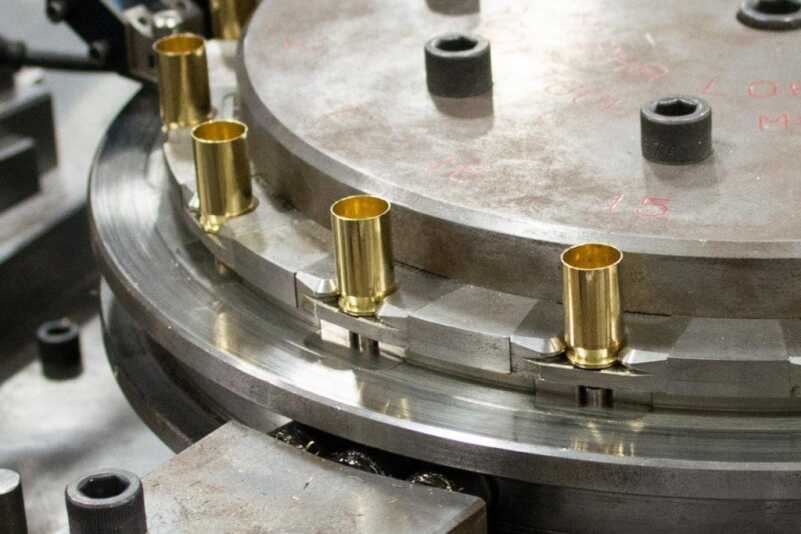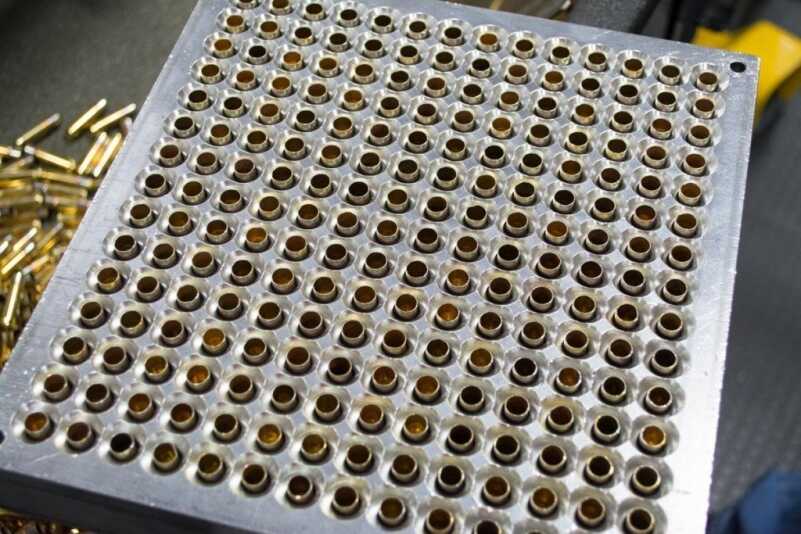
Even the FMJ “practice” ammo goes through rigorous testing. This machine inserts primers and completes a half-dozen or so inspections in the process.
I’ve been shooting the snot out of Sig Sauer’s (relatively) new FMJ ammo the past couple of months and even taking careful notes. As the FMJ line is intended for practice and competition, and not self-defense, I wanted to test a couple of calibers in a variety of guns before reporting back on how it performs.
As the purpose is practice and competition, I’ve tested both velocity and accuracy over time for two different caliber offerings from Sig.

For the 9mm testing, I figured I would keep things in the family, so I used this Sig Sauer P226 Elite SAO.
Sig Sauer Elite Performance FMJ 9mm: This full metal jacket round includes a 115-grain projectile with a rated velocity of 1,185 feet per second. It’s loaded in an all brass (read: reloadable) case that won’t muck up your pistol like the cheap steel and varnished stuff.
Sig Sauer Elite Performance FMJ .45 ACP: The .45 ACP load also has full metal jacket construction but includes a 230-grain projectile. Like the 9mm load, the case is quality brass.
I’m reluctant to refer to this stuff as practice ammo as it’s made to match specifications. I had the pleasure of touring the Sig Sauer ammo factory a couple months back and saw first hand how it’s made. There’s no “less expensive” production line for the FMJ ammo. It’s made on the same line, using the same equipment, as the Elite Performance V-Crown self-defense ammo. While I can’t go into too much detail, I can say that each and every round is lasered, weighed and optically inspected 17 ways from Sunday as it makes it’s way from brass cases to boxed ammo. Sig Sauer uses the tray loading method, so, with the exception of priming, which is done one case at a time, 210 rounds go through each step together. Among other benefits, this allows excellent batch tracking of every cartridge the leaves the factory.
I tested each caliber offering in-depth for velocity, consistency, and accuracy. For velocity testing, I used a Shooting Chrony Beta Master Chronograph placed 15-feet down range and fired ten-shot strings. For some of the accuracy testing, I used a UM Tactical scope rail mount which allowed me to put a Bushnell Elite 2-7x handgun scope on both a Sig Sauer P226 Elite SAO 9mm and a Springfield Armory XDm .45 ACP. The idea was to take out as much human eye error as possible when shooting at 25-yards. The optic allows me to get a very precise sight picture, far better than iron sights alone. Function testing was kind of a non-issue. In the thousand or so rounds I’ve fired between these two calibers of Sig FMJ, I haven’t had any duds or ammo malfunctions.

I used this UM Tactical scope mount with the Bushnell Elite 2-7x handgun scope for 25-yard accuracy testing.
9mm Results
For primary velocity testing, I used the Sig Sauer P226 Elite SAO 9mm single-action handgun. The average I recorded for 10-shot strings was 1,233.7 feet per second, almost 50 feet per second over the figure stated in the marketing material. The extreme spread, or difference between lowest and highest velocity in the string was just 54 feet per second. The calculated standard deviation, or measure of “closeness” of all shots to the mean, was just 15.27. That’s very consistent stuff for practice ammo.
Accuracy was excellent, with 5-shot groups at 25 yards averaging 1.63 inches. The best three were virtually on top of each other in a center to center group of just .63 inches.
For kicks, I also fired 5-shot groups from 15 yards with the new FNS-9 Compact pistol. That center to center group measured 1.59 inches.
.45 ACP Results
I did velocity testing with the .45 ACP FMJ load with a variety of pistols because… range fun! Here are the average velocities.
Springfield Armory TRP 1911 (5-inch barrel): 862.5 fps
Smith & Wesson SW1911 TA (5-inch barrel): 834.0 fps
Smith & Wesson SW1911 Sc (4.25-inch barrel): 783.1 fps
Smith & Wesson SW1911 Pro Series (3.0-inch barrel): 783.1 fps
Springfield Armory XD(M) Threaded (4.5-inch barrel): 858.8 fps
As a side note, I clocked the Springfield Armory XD(M) threaded model while using a SilencerCo Osprey 45 suppressor, mainly because it was awesomely fun.
For a couple of the guns, I did the full spread and deviation math. When fired from the Springfield Armory TRP 1911, the extreme spread was 46.8 feet per second, and standard deviation worked out to 13.62. For the Smith & Wesson SW1911 TA, velocities were even tighter with an extreme spread of just 38.7 feet per second and 11.67 standard deviations.
I did accuracy testing with the Smith & Wesson SW1911 TA, again using the Bushnell Elite handgun scope at 25 yards. Five-shot group? 1.49 inches. Not so shabby.
The net-net is that this “practice” ammo performs more like match ammo. Shooting a match where consistency and accuracy matters? Here’s your huckleberry.




A used Vulcan 9mm Full Metal Jacket and the 45 ACP Full Metal Jacket for”practice”. Both shoot very clean and hold tight groups. I find my Springfield’9mm is less accuate with Sig fmj than my Sig 320 9mm.
Sig 45 (227) does very well. Better than other major brands fmj or reloads.
Can confirm that Sig’s .380 FMJ shoots the tightest groups from my P238. I can keep all 7 on the head at 25 feet. Less can be said from WWB, American Eagle, etc…
I reload and have noticed that hollow point bullet component bullets for reloading are sometimes less expensive than FMJ bullets of the same caliber while the opposite is true for manufactured ammo.
I wonder why factory loadings of the same caliber are often so much more expensive (double) in HP/carry ammo than in FMJ/practice ammo, when manufacturers usually claim equal quality for both?
I wonder if this is another case of pricing rationale of the-because I can — variety. Like .22LR ammo, I suspect a lot of price gouging for lack of a better term, is taking place.
Good piece but Sig Sauer is a living breathing scam company. I say this because many of us bought Sig 556XI as a special modular rifle with a promise that Sig would have conversion kits to other calibers. This has not happened at all and in turn Sig brought out the MCX in essence walking off from those of with 556XI.
It is my belief is DO NOT TRUST SIG. I have totally lost confidence in them period. This includes their ammo.
OK Grow up no one said when the conversion kits were coming, believe I spent half my career waiting for Glock and H&K to come through on their new models and equipment. I have had one issue (minor) in 17 years of using SIG pistols and rifles as a LEO. SIG has always been there for Law Enforcement and the military when we needed them. MCX is just the next evolution trying to meet Government specs on new proposed programs! Have patience and check with the company reps politely and maybe you will get your kits. Semper Fi!
Execellent article. All meat, no fat. Check quality in and confirm results out. Their 45 APC shoots much tighter groups from Sig Sauer 1911s, must be brand loyalty. Lol